| 041
|
CHAPTER 3
Measuring and Fitting Devices
for Children who Need a Special Seat or Standing Aid
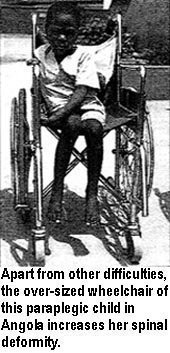
The Need for Careful Measurement and Fitting of Special Seating to
Meet each Child's Needs
If special seating is to help a child sit well, gain better head and
body control, or move and do things more easily, it is essential
that the design be appropriate for the child's needs, and that it fit the
child correctly.
In many parts of the world, one sees disabled children sitting in
specially-made seats or wheelchairs that simply do not fit them. Often the
seat is far too big. Before building a seat for a child, it is important to
take correct measurements. Equally important is to
carefully evaluate the child's individual needs, interests, limitations,
abilities and possibilities, as well as her likes, dislikes, and fears.
The most important test of a special seat is: Does the child
like it?

Even a child who is mentally delayed or cannot express her wishes with
words may have strong feelings about how she is treated or seated. I (the
author) have seen occasions where a beautifully built, accurately fitted
seat is painstakingly made for a child. Yet the child screams every time she
is put in the seat, and despite repeated attempts and coaxing, she never
learns to accept it. (For an example, see page 66.)
Sometimes the child may have good reasons (see the special seat made for a
child with hydrocephalus, page 293). Such a
seat can perhaps be modified or rebuilt so that it is more acceptable. But
clearly, it is preferable to make a seat that from the first comes close
to meeting the child's needs.
One of the best ways to find out what type and size of seating may best
meet a child's needs and preferences is to experiment with a variety
of different pre-existing seats.
| For this reason, PROJIMO likes to keep on hand a
collection of special seats of different types and sizes. Often a seat
that does not quite fit a child can be provisionally adjusted by putting
a block over the footrest or a thick pad against the backrest. If the
angle (tilt) of the seat needs to be changed, try putting one or two
books under the front or back of the seat, according to the child's
particular needs.
Such experimentation, by trial and error, is important before
actually designing and building seat for an individual child. |
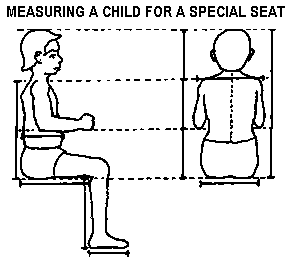
The solid straight lines show the measurements
that are usually needed to build a seat that is the right size for a
child. |
|
| 042
|
An "Evaluation Seat" - for Fitting, Measuring, and Testing to find
the Best Positions for a Child
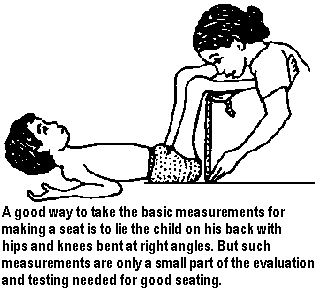
Building an appropriate seat for a child who has a lot of spasticity
or deformities often involves much more than simply taking accurate
measurements of the child. Trials with different seating possibilities can
be very helpful. But a pre-existing seat that both fits the child and has
the combination of features and positions the child needs is often not
available.
PROJIMO has experimented with the design and construction of a completely
adjustable "fitting-and-measuring seat," in which a child of any size can be
tested in a range of positions.
Such a seat needs to have independent adjustments - for width, depth,
height, and for the angle of the seat, the foot-rest, the back, and the
head-rest (when needed). It must also have adjustable, removable supports
for positioning and alignment of the hips, back, shoulders, and head. And it
should have a removable table with adjustable height, angle, hand holds, and
other features.
Fortunately, a physical therapist, Jean Anne Zollars, was making visits
to PROJIMO to help teach short courses on special seating. She helped to
design and build the early experimental special seats.

- Note: Adjustable sides of the seat, and wedges for sideways
stability of the hips, body, and legs are not shown in this sketch, yet
will be needed for some children.
- Headrest: moves up, down, forward, back. Headrest or
its sides are removable.
- Backrest: angle and height are adjustable.
- Lower-back support bar: adjustable.
- Seat: depth and angle adjustable.
- Heel bar: adjustable.
- Blocks: under front and back of base-board, to tilt
the entire seat.
- Foot-rest (and seat height):
adjustable.
- Cross-bar for feet or ankles:
adjustable.
- Leg separator (pommel): adjustable
width, removable.
- Table: adjustable height and angle.
|

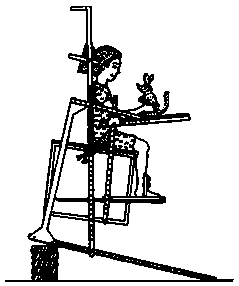
These drawings show how the early, experimental
measuring seat could be adjusted to test a child with the seat tilted
both back and forward (see p.47). |
| The first experimental measuring seats designed and built at PROJIMO
could be modified for children of many sizes and needs. But they were
too complicated, too big, and too difficult to adjust. Eventually, the
team made simpler designs that were easier to adjust. These include the
adjustable seat-with-wheels shown on the next page. |
|
| 043
|
| A wheeled, adjustable measuring seat
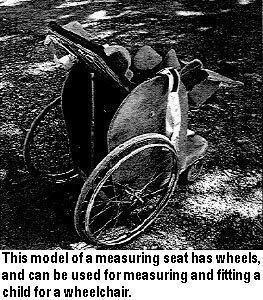
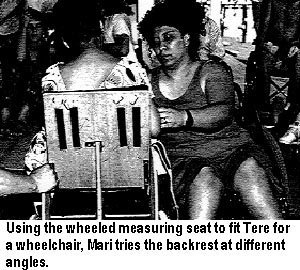
Adjustable wedges
To provide special support for persons who need it, wedges of different
sizes and shapes can be made. For the adjustable wheelchair shown here, the
team molded wedges made of sawdust mixed with white glue. Wedges can also be
made of paper maché or layers of corrugated cardboard (see
page 73).

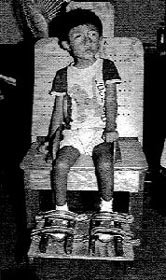
PARTICIPANTS FROM OTHER LANDS IMPROVE THE DESIGN
Some of these measuring seat designs were developed during a series of
short courses at PROJIMO by participants from community rehabilitation
programs in different Latin American countries. One participant in the
course was Monica Rook, an occupational therapist from Holland who was
helping to facilitate a CBR program in Belize. After returning to Belize,
Monica and her team designed a simpler, easier-to-build measuring seat,
details of which are shown on the following page.
It is exciting when course participants improve on innovations in their
own programs and countries.
|
| 044
|
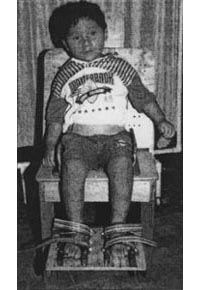 |
The adjustable chair from Belize is made of wood.
Wooden support pieces of various sizes and shapes are attached to the
seat and back of the chair. These can be positioned, adjusted, or
removed depending on the child's needs. The supports - which can be used
to stabilize the feet, hips, trunk, shoulders, and head - are attached
by bolts. These fit through rows of small holes drilled in the footrest,
seat board, and back board. The seat belt and foot straps are also
adjustable. |
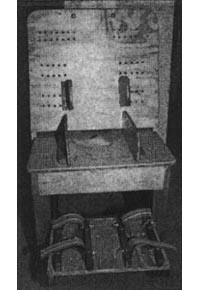 |
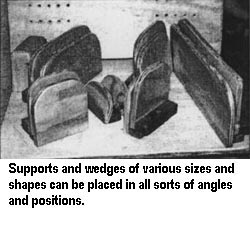
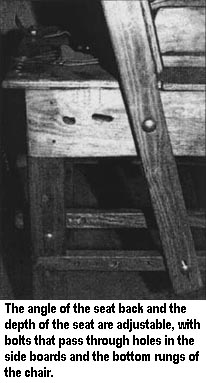
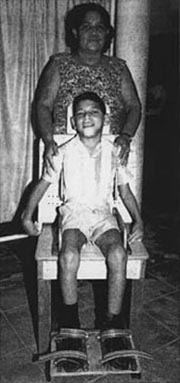
|
| 045
|
An Adjustable Frame for Fitting and Measuring a Child for a Standing
Frame
Using a similar technology with adjustable pieces of wood, Monica Rook
and her team of community rehabilitation workers in Belize also invented a
device for fitting and measuring children who need a custom-made standing
frame.
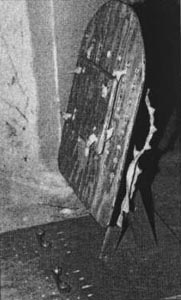
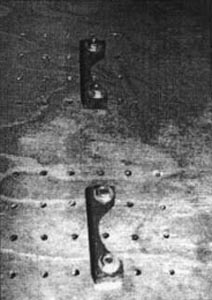

The feet are held in position by wooden heel-stops which can be adjusted
with bolts that pass through the floor board. The standing board is hinged,
and the angle (tilt) can be easily adjusted.

|
| 046
|
Use of Sand-Bags to Help a Child Sit
"Special seating" can sometimes be quite simple. Here the mother of
CRUZ, who has cerebral palsy, helps her son sit upright by
placing sand-bags across his folded legs and behind his hips. Later, PROJIMO
created a cardboard seat for Cruz (see Chapter 8).

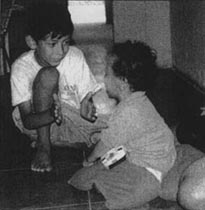

|
|